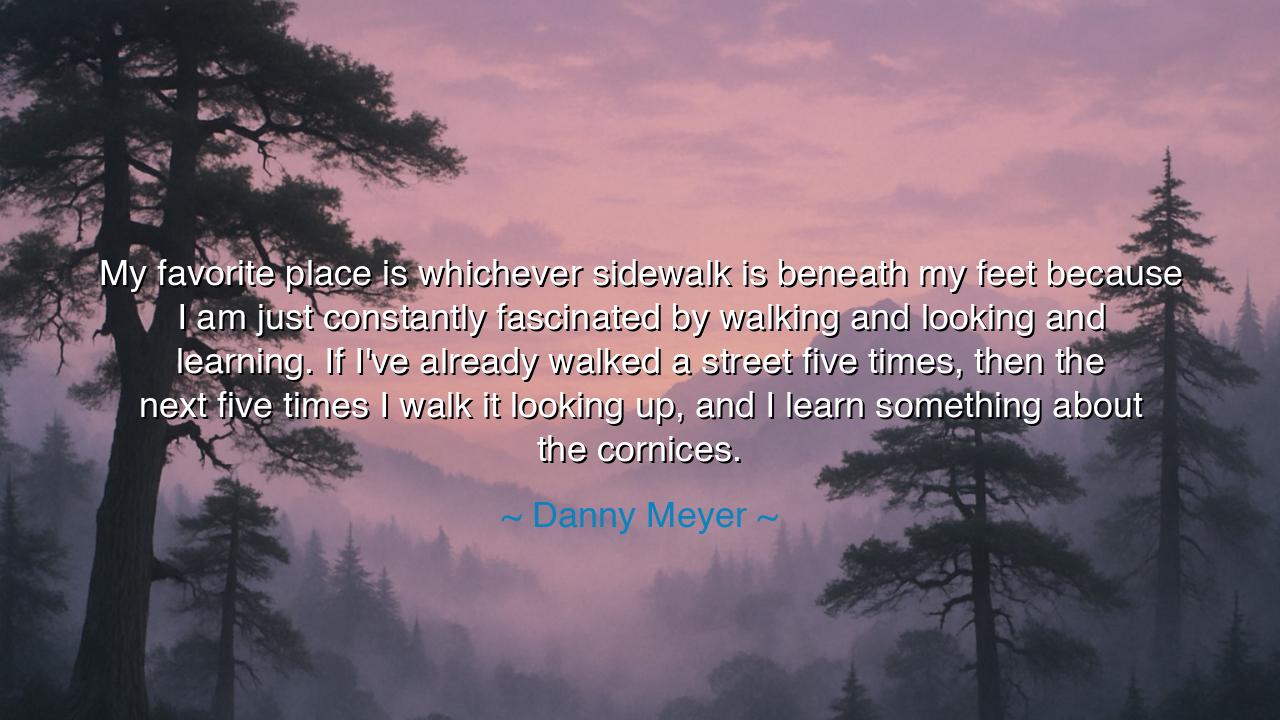
My favorite place is whichever sidewalk is beneath my feet
My favorite place is whichever sidewalk is beneath my feet because I am just constantly fascinated by walking and looking and learning. If I've already walked a street five times, then the next five times I walk it looking up, and I learn something about the cornices.






In a pilgrim’s voice made of city light, Danny Meyer confesses: “My favorite place is whichever sidewalk is beneath my feet because I am just constantly fascinated by walking and looking and learning. If I’ve already walked a street five times, then the next five times I walk it looking up, and I learn something about the cornices.” Hear the creed inside his casual remark: the world offers itself anew to the patient walker. Place is not a fixed picture but a living scroll, unrolling for those who keep reading. The ground gives you one story; the roofline gives you another; together they bind you to a neighborhood with the twine of attention.
He names three instruments—walking, looking, learning—and sets them in sacred order. First we move, then we behold, then we understand. In youth we hurry through avenues as if travel were conquest; with practice we discover that walking is apprenticeship, that the street is a mentor who speaks in small syllables: brick, lintel, shade, threshold. To turn your eyes up is to change the key of the same song; the cornices—those stony eyelids of buildings—begin to wink with carvings and dates, leaves and lions, makers’ marks half-erased by soot. Thus a block you thought you knew becomes a second book bound in the first.
The origin of such wisdom lives in the craft Meyer practices. Hospitality begins at street level: a door that invites instead of intimidates, a sign that smiles, a window that lets people see people. The restaurateur who loves sidewalks learns how footfall turns to fellowship; the cadence of passersby becomes the metronome of welcome. When he says his favorite place is “whichever sidewalk is beneath my feet,” he is revealing the host’s secret: belonging is portable when curiosity is constant. You carry home with you because you keep discovering it under your shoes.
Consider a lamp from real life. A shopkeeper on a narrow block began sweeping not just her stoop but the whole stretch, morning after morning. As she swept, she looked up—noticed a cracked cornice above the bakery, the year “1894” hiding in a pediment, a pigeon path that told where seed spilled daily. She learned the hour the sun warmed the bench; she learned which tree dropped sticky pods and asked the city for a replacement species; she learned her neighbors’ names by their dogs and their hats. Business grew, not because the rent fell or a trend arrived, but because care accumulated, and care made the street hospitable. This is the slow miracle of walking turned into learning.
Another lamp from the annals of cities: Jane Jacobs taught that sidewalks are the stage where “eyes on the street” keep communities safe and alive. Her victory was not only in policy but in posture; she walked and looked, she counted children and stoops, she learned the grammar of lively blocks. Meyer's habit echoes this older music: when you pass the same façade five times and then spend the next five looking at the cornice, you become a custodian of detail. Custodianship breeds affection; affection begets stewardship; stewardship changes how we trade, greet, and build.
The meaning, then, is plain and profound: wonder is not elsewhere; it is angle and attention. The city does not ask for worship but for noticing. Looking up rescues us from the tyranny of the urgent—screens, schedules, self—and returns us to citizenship. We remember that anonymous hands cut those dentils, fired those tiles, hoisted that copper gutter; we become heirs to an unspoken guild of makers. And once we feel ourselves heirs, we behave like ancestors—choosing shop signs, plantings, and public manners as if someone, someday, will study our own small cornices.
What is the lesson to take on your next errand? Make a liturgy of the ordinary street. Walk one block slowly each day; on day one, notice only thresholds; on day two, only shadows; on day three, only materials; on days four through eight, look up—note dates, ornaments, rooflines. Keep a pocket notebook or a phone album titled “sidewalk learning.” Greet one person by name; thank one storefront with a smile left on its glass. If you keep at this, your favorite place will cease to be a distant postcard and will become the ground beneath your feet—renewed, enlarged, and made luminous by the oldest arts: walking, looking, and learning.






AAdministratorAdministrator
Welcome, honored guests. Please leave a comment, we will respond soon